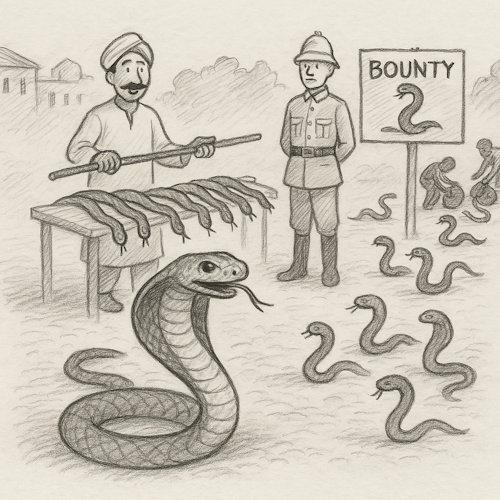The Cobra Effect
Illustrates Unintended Consequences, Goodhart's Law, Systems Thinking
In Agile environments, leaders often set goals to improve performance. But when metrics become targets, behavior changes. Sometimes, that behavior works against the very goal we hoped to achieve. The Cobra Effect is a vivid example of how well-meaning incentives can backfire. Agile teams, Scrum Masters, and leaders can use this parable to explore the risks of misaligned measurement and the importance of systems thinking.

Many years ago, during British colonial rule in India, officials in Delhi became concerned about the number of venomous cobras in the city. To reduce the threat, they offered a bounty for every dead cobra brought to them.
At first, the plan seemed to work. People brought in cobra after cobra, and the numbers dropped.
But soon, clever citizens began breeding cobras to kill them for the reward.
When the government discovered this, they canceled the program. The breeders, now holding worthless snakes, released them.
The cobra population exploded.
What began as a strategy to eliminate danger ended with more cobras than before. The well-intentioned system created a new problem by encouraging gaming instead of solving the root cause.
Lessons Learned
Incentives Shape Behavior
People respond to the system they're in. When rewards are tied to narrow outcomes, individuals may optimize locally while harming the larger goal. Agile teams must be cautious about reward structures that unintentionally encourage shortcuts or manipulation.
Measurement is Not Neutral
Metrics are powerful. When used for learning, they provide insight. When used to evaluate or control, they invite distortion. The key is understanding the behavior a metric encourages, not just the number it produces.
Optimize for the System, Not the Part
The bounty system optimized cobra carcasses, not public safety. Agile teams should look beyond functional metrics to system-level outcomes. Are we improving flow, reducing delay, and delivering value? Or just hitting the numbers?
Root Causes Matter
Killing cobras addressed the symptom. The breeding problem arose because the root causes, habitat conditions, urban planning, community safety, were untouched. Agile thinking focuses on cause-and-effect, not just quick wins.
Gamification is Not Always Fun
Some leaders try to "gamify" metrics to boost morale or productivity. But if teams feel manipulated, trust erodes. Agile thrives in psychologically safe environments. Metrics should be transparent tools for collective reflection, not levers for silent pressure.
Coaching Tips
- Ask the Cobra Question: When a team adopts a new KPI or policy, ask, "How might this be gamed?" or "What behavior are we unintentionally encouraging?"
- Decouple Metrics from Judgment: Encourage teams to use measures like velocity, throughput, or bug count for self-inspection, not external evaluation.
- Teach Systems Thinking: Use this story to introduce concepts like feedback loops, unintended consequences, and the limits of linear cause-effect thinking.
- Coach Leaders to Look for Patterns: If gaming behavior is present, help leaders explore systemic causes rather than blaming individuals.
- Facilitate Experiments, Not Punishment: Shift conversations from "Why are the numbers wrong?" to "What did we learn?" or "What might we change in the system?"
The Cobra Effect reminds us that metrics are not just tools, they are signals. Agile coaches and leaders must stay curious about the systems those signals live within. If a team is hitting all the numbers but still struggling, we may be measuring the wrong things.
Agile success depends not on clever plans, but on honest learning. When we focus on outcomes, not optics, we trade control for clarity, and avoid breeding more problems than we solve.


